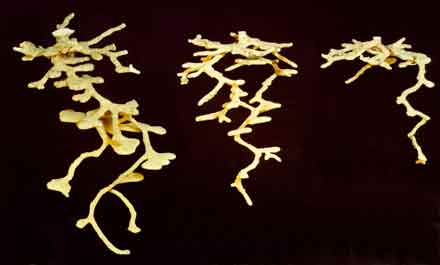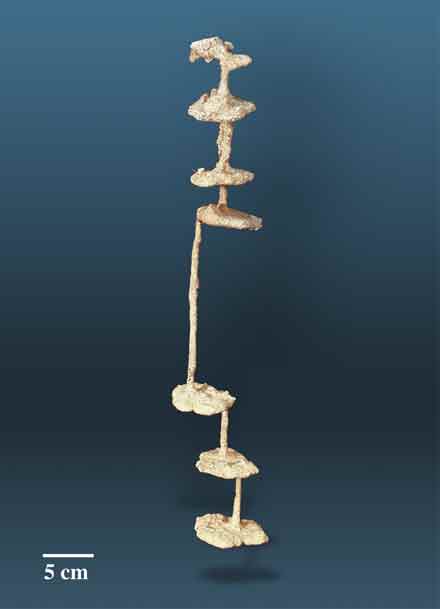This is 'Comfort Hair,' A Live Sculpture That Beautifully
Explores Women's Cultural Identities
Explores Women's Cultural Identities
Katherine Brooks, Senior Arts and Culture Editor, Huffington Post
Yuni Kim Lang doesn’t just make sculpture, she makes live sculpture.
The Korean-American artist’s signature artwork, “Comfort Hair,” doesn’t
come with a tiny beating heart, if that’s what you’re thinking. The “live”
modifier refers to the fact that the sculpture is more performance that
stationary object. The piece requires a person — a wearer — to make
the work whole. And when wearer meets sculpture, meaning pours forth.
The massive pile of dark, woven hair becomes a totem of cultural identity,
and a visual reminder of history’s obsession with long flowing locks.
come with a tiny beating heart, if that’s what you’re thinking. The “live”
modifier refers to the fact that the sculpture is more performance that
stationary object. The piece requires a person — a wearer — to make
the work whole. And when wearer meets sculpture, meaning pours forth.
The massive pile of dark, woven hair becomes a totem of cultural identity,
and a visual reminder of history’s obsession with long flowing locks.
“Comfort Hair” was inspired by the Korean practice of wearing a cache,
a large, heavy wig typically found on the heads of wealthy, high society
women. Like these raven-hued fixtures that epitomized the “bigger is better”
mantra, Lang’s sculpture appears like a massive pile of hair made from
polypropylene rope that sits atop a model’s head for one hour at a time.
a large, heavy wig typically found on the heads of wealthy, high society
women. Like these raven-hued fixtures that epitomized the “bigger is better”
mantra, Lang’s sculpture appears like a massive pile of hair made from
polypropylene rope that sits atop a model’s head for one hour at a time.
The gache is just one historical example that illuminates humanity’s greater
obsession with manes, mops, curls and tresses. Over the centuries, “hair
has symbolized so many different things,” Lang told The Huffington Post,
despite the fact that the only “living” portion of hair remains hidden inside
the follicle. “The obsession we have with our dead hair that we imagine
to be full of life is fascinating. It is the part of the body that has no nerves
or muscles but has movements and rhythm that feel alive. When you cut
it off there is no pain and it does not bleed. Yet, we perceive it as a
sacred entity.”
obsession with manes, mops, curls and tresses. Over the centuries, “hair
has symbolized so many different things,” Lang told The Huffington Post,
despite the fact that the only “living” portion of hair remains hidden inside
the follicle. “The obsession we have with our dead hair that we imagine
to be full of life is fascinating. It is the part of the body that has no nerves
or muscles but has movements and rhythm that feel alive. When you cut
it off there is no pain and it does not bleed. Yet, we perceive it as a
sacred entity.”
While history at large has undoubtedly obsessed over hair — from
yesterday’s Victorian wigs to today’s Instagrammable cuts — hair is,
of course, as much a personal experience as it is a shared one.
yesterday’s Victorian wigs to today’s Instagrammable cuts — hair is,
of course, as much a personal experience as it is a shared one.
“‘Comfort Hair’ was conceived because of the way I was brought up,
as a third culture kid,” Lang explained. Third culture kid (TCK), she
elaborated, is a term used to refer to people who have spent a significant
amount of their developmental years in cultures other than the ones they
were born into. “Being a Korean growing up in China, going to an
American International school, I was sorting through three different
cultures to makes sense out of my own. The amalgamation of these
three cultures has become my personal cultural identity.”
as a third culture kid,” Lang explained. Third culture kid (TCK), she
elaborated, is a term used to refer to people who have spent a significant
amount of their developmental years in cultures other than the ones they
were born into. “Being a Korean growing up in China, going to an
American International school, I was sorting through three different
cultures to makes sense out of my own. The amalgamation of these
three cultures has become my personal cultural identity.”
According to Lang, the thing that makes the TCK experience so unique
is that it involves tough questions regarding personal cultural identity
— even confusion — at a very early stage in your life. For Lang, this
first happened when she was three years old. “It is truly unique in the
sense that these individuals are moving between cultures before they
even have the opportunity to fully develop their personal and
cultural identity,” she said.
is that it involves tough questions regarding personal cultural identity
— even confusion — at a very early stage in your life. For Lang, this
first happened when she was three years old. “It is truly unique in the
sense that these individuals are moving between cultures before they
even have the opportunity to fully develop their personal and
cultural identity,” she said.
After each “Comfort Hair” performance, Lang tells us, the wearer
ceremoniously sheds the gache-esque work. “The action of shedding
the hair piece is like shedding a layer of skin,” she added. It’s the same
idea behind a reptile shedding its skin regularly to allow room for growth.
“The main reason for shedding is that their older skin does not grow
with them, so in order to grow they need to shed the old, allowing the
new skin to form below the old one. This is the idea behind the
performance. Our identities are ever evolving and growing and it is
a crucial part of the growth that we also shed a layer of us behind.”
ceremoniously sheds the gache-esque work. “The action of shedding
the hair piece is like shedding a layer of skin,” she added. It’s the same
idea behind a reptile shedding its skin regularly to allow room for growth.
“The main reason for shedding is that their older skin does not grow
with them, so in order to grow they need to shed the old, allowing the
new skin to form below the old one. This is the idea behind the
performance. Our identities are ever evolving and growing and it is
a crucial part of the growth that we also shed a layer of us behind.”
“I fantasize about my hair,” Lang concluded. “It stands in for my
cultural identity which is becoming an organism that continues to
grow and prosper. Hair is always personal and my work is definitely
very personal.”
cultural identity which is becoming an organism that continues to
grow and prosper. Hair is always personal and my work is definitely
very personal.”
Photographs of “Comfort Hair” will be on view at
John Michael Kohler Arts Center in Sheboygan, Wisconsin,
as part of the “Towards Textiles” exhibition, until Oct. 11, 2015.
John Michael Kohler Arts Center in Sheboygan, Wisconsin,
as part of the “Towards Textiles” exhibition, until Oct. 11, 2015.
source huggingtonpost.com

















































